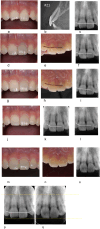Transient Apical Breakdown: Incidence, Pathogenesis, and Healing
- PMID: 39445627
- PMCID: PMC11791466
- DOI: 10.1111/edt.13002
Transient Apical Breakdown: Incidence, Pathogenesis, and Healing
Abstract
Background/aims: Transient apical breakdown (TAB) is a phenomenon that indicates temporary apical periodontal destruction and root resorption after tooth luxation injuries, followed by the healing process of the dental pulp. Andreasen in 1986, reported that TAB was seen in approximately 4.2% of all luxation injuries. However, there have been no reports thereafter on the types and frequency of the luxation traumatic injuries in which TAB occurs. Therefore, this retrospective study was aimed to assess the incidence and pathogenesis of dental trauma-induced TAB and to suggest a possible mechanism of subsequent healing based on a series of cases.
Methods: Data analysis included mature teeth (n = 56) of 49 patients aged 9-30 years who presented in a private dental office over a period of 10 years (2012-2022) to investigate the incidence and healing sequala of TAB.
Results: TAB was observed in 43.8% of subluxation, 62.5% of extrusive luxation, and 75% of lateral luxation injuries. The average age of patients who developed TAB was 14.5 years, ranging from 9 to 28 years old.
Conclusions: TAB can be expected in many cases of luxation injuries with minimal dislocation. Therefore, mild injuries (subluxation, extrusion, and lateral luxation), may exhibit spontaneous healing, recovery of dark discoloration of the crown, disappearance of a periapical radiolucent lesion and return to normal response to EPT as long as 12 months after the traumatic injury. Thus, a decision to perform endodontic treatment in these cases might be postponed until clear evidence for an infection exists.
Keywords: apical periodontitis; avulsion; concussion; dental trauma; intrusion; luxation; resorption.
© 2024 The Author(s). Dental Traumatology published by John Wiley & Sons Ltd.
Conflict of interest statement
The authors declare no conflicts of interest.
Figures





References
-
- Andreasen F. M., “Transient Apical Breakdown and Its Relation to Color and Sensibility Changes After Luxation Injuries to Teeth,” Endodontics & Dental Traumatology 2 (1986): 9–19. - PubMed
-
- Cohenca N., Karni S., and Rotstein I., “Transient Apical Breakdown Following Tooth Luxation,” Dental Traumatology 19 (2003): 289–291. - PubMed
-
- Boyd K. S., “Transient Apical Breakdown Following Subluxation Injury: A Case Report,” Endodontics & Dental Traumatology 11 (1995): 37–40. - PubMed
-
- Zhu Z., “Transient Apical Breakdown of a Discoloured Maxillary Central Incisor During Orthodontic Treatment: A Case Report,” Australian Endodontic Journal 49, no. S1 (2023): 476–480. - PubMed
-
- González O. L., Vera J., Orozco M. S., Mancera J. T., González K. V., and Malagón G. V., “Transient Apical Breakdown and Its Relationship With Orthodontic Forces: A Case Report,” Journal of Endodontia 40, no. 8 (2014): 1265–1267. - PubMed
MeSH terms
LinkOut - more resources
Full Text Sources

